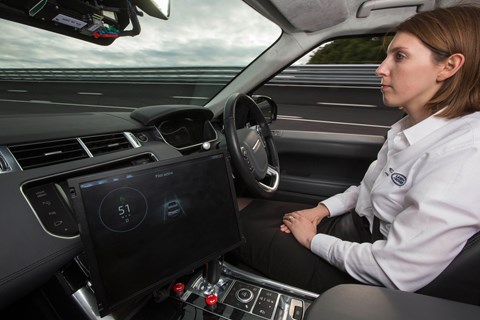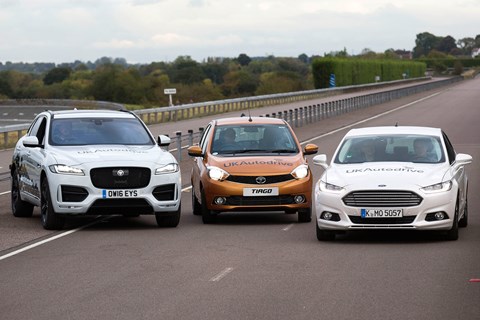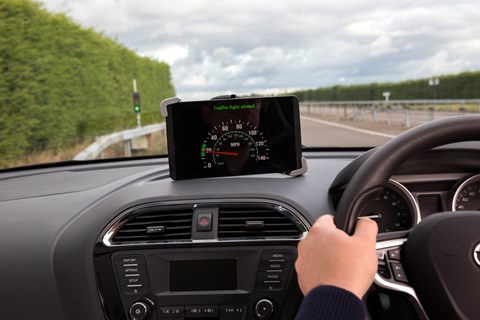► We ride in a self-driving Range Rover Sport
► Connected braking in a Ford Mondeo also tested
► Part of £20m connected and autonomous cars project
Jaguar Land Rover plans to sell cars that can autonomously overtake by 2019 – and we’ve ridden in a prototype Range Rover Sport with this fledgling capability. That’s a self-driving power beyond the impressive abilities of the semi-autonomous Tesla Model S and Model X in production today: the big difference is the British 4×4 decides for itself whether to implement an overtake, whereas any Tesla manoeuvre currently has to be driver-instigated with a pull on the indicator stalk.
The demonstration took place at the MIRA test facility in the Midlands, as part of a £20m development project called UK Autodrive. Jaguar Land Rover, Ford and Tata Motor’s UK engineering centre are the big OEM names involved, along with suppliers, local authorities and universities. The goal is to prove the UK’s prowess in developing connected and autonomous cars, a trend that could create 320,000 jobs and deliver £51bn of social and economic benefit here by 2030, according to calculations by financial experts KPMG.
Riding in the autonomous Range Rover
JLR calls its party trick Advanced Highway Assist, and the programme was coded by engineer Amy Rimmer, who’s at the wheel. She accelerates the Sport up to 50mph, then pushes the ‘resume’ button, a control familiar to anyone with a cruise control-equipped Jag or Landie. We’re on the MIRA bowl, pulling a light 0.2g in the bends – a lateral load you can feel – and the Range Rover Sport’s electronics take control.

Much of the critical hardware is already fitted to today’s Range Sports: the Blindspot Information System, which scans for potentially hidden vehicles storming up in an adjacent lane, and the self-steering, stopping and accelerating abilities of the electric power assisted steering and adaptive cruise control. There’s also a forward facing camera to read the white lines and keep us in the lane, though this is significantly upgraded over the camera fitted as standard on Jaguar’s XE. The boot’s full of circuit boards, wires and processing power, too.
Amy resolutely has her hands in her lap, and her feet off the pedals, though she’s on alert and fully trained and certified to handle any unexpected manoeuvres. The Range Sport cruises forward, closing in on another Range Rover Sport control vehicle. The indicator starts signalling right, and the Sport pulls out – not too quickly, avoiding unsettling the vehicle, but not so slowly as to unsettle the occupants by appearing dithery. It passes its ambling fellow SUV, indicates and returns to the nearside lane.
Next thing is to test its ability to see vehicles in its blindspot. Another control Range Rover is called up alongside, and we witness… well, nothing in particular – because the Sport refuses to changes lanes. Its digital display shows an illustration with the adjacent lane bathed in red, offering a visual explanation as to why we’re patiently trailing a slower vehicle. Unless you’re glued to Amy’s lack of hand movements, it’s easy to zone out and forget you’re progressing in anything like a routine manner – until at one point the camera inexplicably loses sight of the markings it’s followed for many laps today. The Sport begins to lurch out of lane, but Amy swiftly corrects the wandering SUV, and ‘highway’ driving becomes boringly unexceptional again. Which is exactly how we need our autonomous cars.

JLR expects the system – which will also bring the vehicle to a stop in the nearside lane, if the driver fails to step in when the car requests to hand back control – to be in production in three years maximum. That’s assuming the relevant legal and regulatory hurdles have been overcome, mind – such as who’s responsible in the event of an accident. That’s why insurance and legal experts are also part of the UK Autodrive consortium.
Other UK Autodrive demos – by Ford and Tata
The three-year project is also investigating the benefits of connected cars. A Ford Mondeo hybrid, Tata Tiago supermini and Jaguar F-Pace are all connected by Dedicated Short Range Communications (DSRC), sharing each car’s data up to 1km apart. We ride in a convoy considerably closer – less than 20m apart – with the small Tata upfront, obscured from the last-placed Mondeo by the F-Pace meat in the sandwich.

Periodically the Tiago performs a series of sharp braking manoeuvres: thanks to DSRC, the Mondeo receives visuals warnings that an obscured hazard could cause the F-Pace to jam on its anchors. In this instance the driver has to respond, but in the autonomous future this active safety feature could autonomously brake cars to prevent rear-end collisions. This feature would be a blessing in dense fog (and perfection if it could remind dozy drivers to turn off their fog light once visibility has improved). It’s also encouraging – and essential – that manufacturers are developing ways for different cars with different hardware and software to find ways of communicating, regardless of brand.
The final demonstration advises when a traffic light will change, again using DSRC to link the road infrastructure with approaching cars. Get within 500m of the light in the Tata and the display warns of a traffic light broadcasting its cycle ahead. Software then calculates how fast or slowly you must drive – neither breaking the speed limit, nor progressing so leisurely as to incense traffic behind – to reach the light on its current or next green cycle. The objective is to keep traffic flowing, saving fuel and reducing carbon emissions by making cars brake and accelerate less. There will also be a congestion-busting upside, which excites Tata – as it would be a brilliant benefit for the congested megacities in its home market of India.
Read more CAR tech news and features
